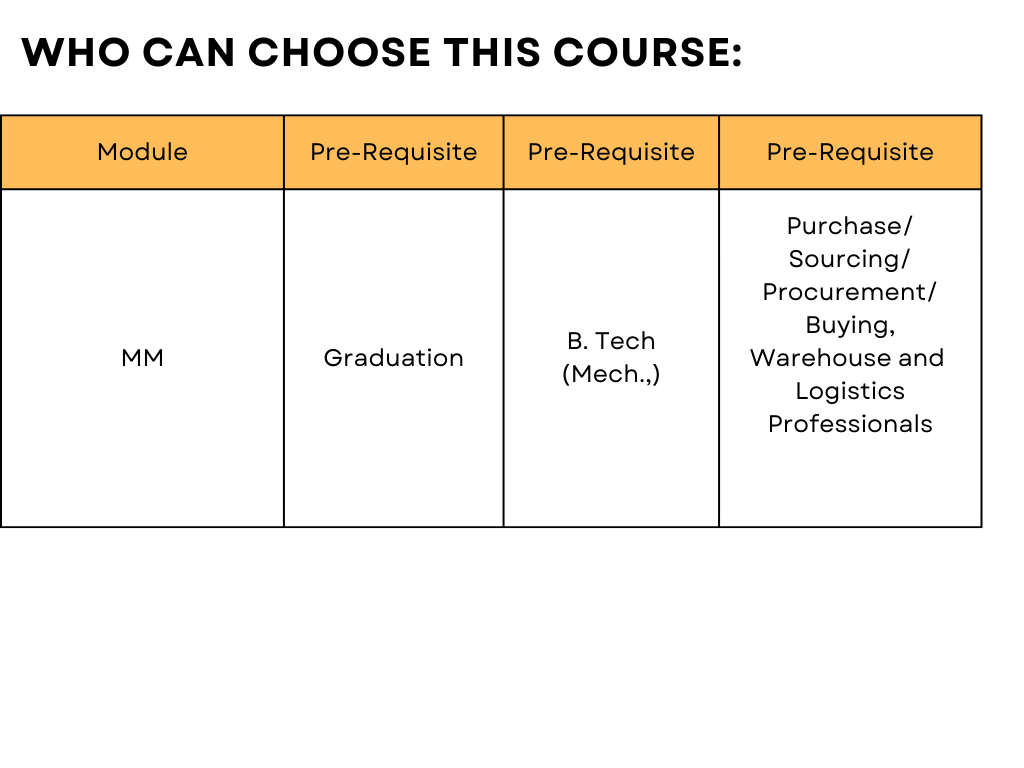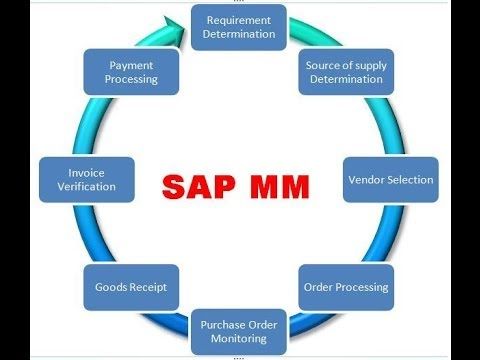SAP-MM
Eligibility for a course typically depends on the following:
- Prerequisites: Required prior courses or skills.
- Level of Study: Undergraduate, graduate, or continuing education.
- Program Requirements: Specific to your major or program.
- Open Enrollment: Available to all students as an elective.
- Special Permissions: Might need instructor or department approval.
- Availability: Limited seats may give priority to certain students.
- Location/Delivery: Online or specific campus availability.
Check the course catalog or consult with an academic advisor for specifics.

SAP-MM (Materials Management)
SAP-MM (Materials Management)
SAP Material Management (MM)is also a Functional Module where we map Purchase Function of an Organization in this Module. Professional who are working in Purchase, Sourcing, Procurement, Stores and Ware House Depts., can learn MM Module and enter into IT Industry. Students or Freshers with B.Tech etc., degrees also can learn MM Module and become an SAP Consultant.

SAP-MM COURSE CONTENT
SAP-MM COURSE CONTENT
• New Processes in SAP ERP 6.0
• New Functions in Master Data and Purchasing
• New Functions in Inventory Management
• New Functions in Invoice Verification
• Appendix: New Functions in SAP R/3 Enterprise and SAP ERP 5.0
Quality Management in Logistics
• Inventory management with QM, inspection stock, and inspection lot
• Goods receipt and goods issue inspection
• inspections of goods movements
• Control of the procurement process
o Vendor release, model processing
o Vendor’s QM system
• Procurement documents and certificates
• Planning and creating quality certificates for outbound deliveries
SAP Navigation – Free with SAP Learning Hub discovery edition
• The SAP Navigation course is designed to familiarize learners with key terms and how to navigate within the SAP system.
• Logging on and off
• Understanding and recognizing SAP screens, menus, fields, and special features
• Recognizing SAP icons
• Find out how to use ‘Application Help’ and the SAP Library
• Set up ‘Favorites’ for frequently used transactions
• Understanding system messages
• Set up default values
• Navigate SAP standard reports
• Test your knowledge through review questions and system simulations
Processes in Procurement
• Procurement Processes
o Defining Processes and Organizational Levels in Procurement
o Maintaining Purchase Orders
o Posting Goods Receipts
o Entering Invoices
• Master Data
o Maintaining Vendor Master Records
o Maintaining Material Master Records
o Using Entry Aids for Master Data Maintenance
o Performing Mass Maintenance
• Stock Material Procurement
o Applying Conditions in Purchasing
o Handling Requests for Quotations and Quotation Processes
o Creating Purchase Orders with Reference
o Maintaining Purchasing Info Records
o Analyzing Material Valuation
o Posting Goods Receipts for Purchase Orders
o Entering Invoices with Reference to Purchase Orders
• Consumable Material Procurement
o Purchasing Consumable Materials
o Creating Purchase Requisitions
o Creating Purchase Orders with Reference to Purchase Requisitions
o Entering Valuated and Non-Valuated Goods Receipts
o Creating Blanket Purchase Orders
• External Services Procurement
o Maintaining Master Data for External Services
o Ordering Services
o Creating Service Entries and Verifying Invoices
• Automated Procurement
o Maintaining Data for Material Requirements Planning (MRP)
o Maintaining Contracts and Source Lists
o Performing Procurement Processes Automatically
• Reporting and Analytics
o Using Standard Reports
o Performing Standard Analyses in the Logistics Information System
• Introduction to the SAP Buyer Role
o Assessing the Buyer Role
o Self-Service Procurement
• Examining the Functions of Self-Service Procurement
Inventory Management and Physical Inventory
• Introduction to Inventory Management
o Defining Inventory Management and Physical Inventory
• Moving Goods with the MIGO Transaction
• Goods Receipts (GRs)
o Posting a GR Without Reference
o Posting a GR with Reference
o Posting a GR with Automatic Generation of a PO
o Posting Cancellations, Return Deliveries, and Returns
o Applying Order Price Unit in Inventory Management
o Applying Tolerances and the Delivery Completed Indicator
o Adding Date Checks to GRs for a PO
• Stock Transfers and Transfer Postings
o Performing Stock Transfers Between Storage Locations
o Performing Stock Transfers Between Plants
o Performing Transfer Postings
• Reservations
o Creating Manual Reservations
o Evaluating Reservations
o Checking Availability and Missing Parts
• Goods Issues (GIs)
o Posting Unplanned GIs
o Posting a GI with Reference
o Configuring Stock Determination
o Allowing Negative Stock
• Special Forms of Procurement and Special Stocks
o Performing the Process of Subcontracting
o Performing Vendor Consignment
o Operating Pipeline Processes
o Posting Goods Movements for Special Stocks
• Special Features of Material Valuation
o Posting Goods Movements for Material Types UNBW and NLAG
o Configuring Split Valuation
• Physical Inventory
o Conducting Physical Inventory
o Analyzing the Determination of Book Inventory
o Simplifying Physical Inventory
o Applying Cycle Counting
o Applying Inventory Sampling
• Analyses
o Applying Stock Lists and Document Lists
o Applying Periodic Processing
• Customizing
o Implementing Settings for Documents
o Setting Up Movement Types
o Applying Other Customizing Settings
• Logistics Execution
o Managing Logistics Execution Processes
o Posting a GR Against a PO
o Posting a GI for a Sales Order
Invoice Verification
• Introduction to invoice verification
• Invoice entry and parking
• Taxes, cash discounts, and foreign currency
• Invoices for purchase orders with account assignment
• Variances with and without reference to an item, invoice blocking reasons
• Invoice reduction, releasing blocked invoices
• Delivery costs
• Subsequent debits and credits
• Credit memos and cancellations
• Invoice verification in the background
• Automated processing
• GR/IR clearing account maintenance
• Customizing for invoice verification
Purchasing
• Master data for purchasing
• Sources of supply: info records, contracts, and scheduling agreements
• Source determination
• Optimized purchasing
• Special procurement processes
• Document release (approval) procedure
• Vendor evaluation
• Customizing
• Vendor master records
• Document types
• User parameters
• Integrated scenarios with SAP SCM and SAP SRM
• Purchasing Master Data
o Creating Material Master Records for Purchasing
o Creating Vendor Master Records for Purchasing
o Using Partner Functions in Purchasing
• Sources of Supply and Conditions
o Analyzing Price Determination Basics
o Creating Purchasing Info Records
o Creating Special Info Records
o Using Special Functions in Info Records
o Creating Central Contracts
o Creating Contracts for Material Groups
o Creating Scheduling Agreements Without Release Documentation
o Creating Scheduling Agreements with Release Documentation
o Source Determination
• Controlling Source Determination with Source Lists
o Maintaining Source Lists
o Controlling Source Determination with Quota Arrangements
o Executing the Planning Run with Quota Arrangements
o Identifying Additional Aspects of Source Determination
o Blocking Sources of Supply
o Creating Purchase Orders with Source Determination
• Optimized Purchasing
o Processing Unassigned Purchase Requisitions
o Processing Assigned Purchase Requisitions
o Monitoring Purchase Orders
o Assessing the Buyer Role
• Document Release Procedure
o Releasing Purchasing Documents
o Converting Released Purchase Requisitions
o Configuring Release Procedures in Customizing
o Creating Release Procedures
• Specific Procurement Processes
• Creating Invoices Using Invoice Plans
• Creating Blanket Purchase Orders
o Deploying Subcontracting
o Purchasing with Manufacturer Part Numbers
o Deploying Additional Special Procurement Processes
• Vendor Evaluation
o Evaluating Vendors
o Setting Up Vendor Evaluation
• Purchasing Document Types
o Customizing Document Types in Purchasing
o Setting Up Field Selection in Purchasing Documents
o Deploying Version Management in Purchasing
o Analyzing Special Aspects in Customizing
o Defining Function Authorizations for Buyers
• Integrated Procurement Scenarios
o Purchasing with SRM and Catalogs
o Integrating SAP Components
Consumption-Based Planning and Forecasting
• Consumption-Based Planning
o Describing the Material Requirements Planning (MRP) Process
o Defining MRP Procedures
o Maintaining the Material Master
o Setting Up a Reorder Point Planning
• Planning Run
o Describing the Planning Run
o Executing a Planning Run
o Converting Planning Results
o Evaluating the Planning Results
o Calculating Lot Sizes
• Forecasting
o Explaining Basics of the Forecast
o Executing and Post processing the Forecast
o Performing Forecast-Based Planning
o Performing the Time-Phased Planning
o Performing Automatic Reorder Point Planning
• Additional Options in Consumption-Based Planning
o Explaining Source Determination in Materials Planning
o Planning Storage Locations Separately
o Using MRP Areas in Planning
o Enabling Stakeholders for Mobility
Cross-Functional Customizing in Materials Management
• Solution Manager and Customizing Projects
o Defining Customizing Projects
o General Settings
o Checking Countries and Currencies
o Defining Units of Measurements
o Setting Up a Factory Calendar
• Organizational Units
o Defining Organizational Units in Materials Management
o Defining and Assigning Plants
• Master Data
o Setting Up Material Master Records
o Creating Material Types
o Setting Up Field Selection for Material Master Records
o Defining Field References for Material Master Records
o Configuring the Material Master
o Defining Settings for Vendor Master Records
• Valuation and Account Assignment
o Describing Automatic Account Determination
o Determining the Relevance of Company Codes and Valuation Areas
o Creating Valuation Classes and Account Category References
o Setting Up Account Determination for Specific Transactions
o Subdividing a Transaction with the Account Grouping Code
o Adjusting Account Determination for Special Cases
o Adjusting Settings for Split Valuation
• Purchasing
o Creating Document Types in Purchasing
o Using Document Types in Purchasing
o Creating Account Assignment Categories
o Adjusting the Screen Layout of Purchasing Documents
o Defining Text Types and Text Adoption
o Specifying Texts for Output Processing
o Controlling the Output of Messages in Purchasing
o Using Condition Technique for Message Determination
• Inventory Management
o Adjusting Settings for Material and Accounting Documents
o Adjusting Settings for Goods Movements
o Adjusting the Output of Messages in Inventory Management
Materials Management Archiving Purchasing Documents
• Define archiving and its benefits, and explain and demonstrate the SAP functionality for archiving purchasing documents
• Identify and verify the system and document settings necessary for archiving purchasing documents
• Identify and demonstrate the periodic tasks for performing a purchasing document archiving process in SAP, and demonstrate the steps to access and view archived documents
Pricing in Purchasing
• Elements of the condition technique
• Price determination
• Header and group conditions
• Maintaining conditions
• Special condition types and functions
• Conditions for services
• Variant conditions
• Subsequent settlement
• Customizing
Procurement of Services
• Master data
• Service specifications
• Sources of supply and optimized procurement
• Value limits for unplanned services
• Invoice verification for services
• Integration with other ERP processes
• Integration with SRM sourcing
Availability Check (ATP)
• Demonstration and configuration of the availability check on the Basis of the ATP Quantities in SAP ERP
• Demonstration and configuration of the availability check against product allocation in SAP ERP
• Demonstration and configuration of the availability check against planning in SAP ERP
• Backorder processing in SAP ERP
Cross-Application Processes in ERP MM and SD
• Third-party order processing
• Cross-company-code sales
• Stock transfers within a company code
• Cross-company-code stock transfers
• Subcontracting
• Advanced Returns Management (supplier and customer returns)
Supplier Collaboration with SAP SNC
• SAP SNC Overview and system landscape
• Purchase Order Process
• Release Process
• Master data
• ASN Processing
• Invoice Collaboration
• Supplier Managed Inventory (SMI)
• Download / Upload Center
• Exception Management
• Further Processes (high-level and without exercises)
o Work Order
o Supply Network Inventory (SNI)
o Delivery Control Monitor (DCM)
o Dynamic Replenishment (DR)
o Kanban
